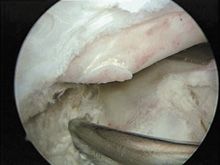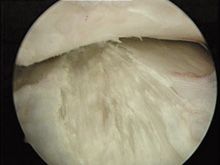Making the most of veterinary equine arthroscopy
Equine arthroscopy is commonly used to manage problems in carpal joints, hocks and stifles. But what about managing a tear in a flexor tendon or navicular bursa? Get your moneys worth out of this instrumentand provide optimal patient careby giving some less conventional uses a try.

Getty ImagesWhile arthroscopy is often used for stifles, carpal joints, hocks and fetlocks, Carter Judy, DVM, DACVS, of Alamo Pintado Equine Medical Center in Los Olivos, California, thinks equine veterinarians should consider inserting the arthroscope in other locations they might not as readily consider, such as tendon sheaths and navicular bursae.
“Practitioners might think that certain locations are inaccessible or not amenable to such procedures, but they are,” Judy says. These procedures have been well-documented, and a number of new indications for arthroscopic surgery have been reported. Many of these procedures have been updated in recent editions of the textbook Diagnostic and Surgical Arthroscopy in the Horse.1,2
Arthroscopy is a simple procedure and can be used with fairly minimal complication. It also provides a way to more accurately diagnose and subsequently treat some problems not thought to be treatable with this technique in the past.
“Some people might say going into a navicular bursa with a scope might be a concern,” Judy says. “It's a small location, and using such a procedure may cause more damage. That's not necessarily so. It's been found to be useful there. Depending on the condition or injury, arthroscopy needs to be selected when it's appropriate.”
Arthroscopy of small joints
C. Wayne McIlwraith, BVSc, PhD, FRCVS, DSc, DACVS, DECVS, DACVSMR, a University Distinguished Professor and director of the Orthopaedic Research Center at Colorado State University, College of Veterinary Medicine and Biomedical Sciences and the author of Diagnostic and Surgical Arthroscopy in the Horse, describes some of the difficulties of small joint arthroscopy and some of the ways it differs from arthroscopy of large joints:
> The exact anatomic positioning of the arthroscope and instrument portals is important in all small joints.
> Limited distention in small joints results in a limited field of view.
> Limited distention and mobility in small joints leads to difficulties in orientation.
> The tip of the arthroscope and the tips of instruments are close together and close to the tissue being operated on.
> The tip of the arthroscope is always close to the tip of the hand instruments, which increases the risk of lens damage.
> Diagnostic inspection of a small joint is done mainly by lateral movement and rotation of the telescope rather than by inserting and withdrawing the arthroscope as in larger joints.
> Re-arthroscopy is almost always performed through the same initial portals.
> It is a delicate surgery with delicate surgical equipment. Equipment breakage or equipment failure can potentially result in irretrievable loss of foreign bodies.1
Tendon sheaths
Arthroscopic technique can be used to diagnose and treat problems in tendon sheaths and is particularly useful in managing an undiagnosed flexor tendon tear.
“A particular horse had a tendon sheath effusion that was problematic for a very long time,” Judy says. “There were suspicions that it had tendon sheath adhesions. The referring veterinarian passed it to us because he wanted us to débride the adhesions. In reality, once I got in there [with the arthroscope], I was able to find a fairly significant tear of the deep flexor tendon. So the procedure was not only useful in treatment, but it produced a more accurate diagnosis. We were able to deal with the sheath tear appropriately.”
Similarly, arthroscopy can be helpful for a variety of tendon sheath treatments. “A combination of arthroscopy and MRI is often the ultimate diagnostic combination, but in some cases, we don't have the option of both because of the cost. There is just one shot at one thing,” Judy says. “I've got a case coming up in which we're scoping an extensor tendon sheath in the knee for a large hygroma. With this large swollen knee, we're going in with the scope to ablate the lining of the extensor tendon sheath and help the swelling to come down.”
McIlwraith describes tenoscopy of the digital tendon sheaths and the carpal sheaths for the removal of radial osteochondromas and for superior check desmotomy as well as other common procedures.1
“The extensor sheaths over the carpus are also sometimes injured on the dorsal aspect of the limb,” he says. “Blunt trauma can result in variable degrees of tendonitis and chronic effusion of the sheath. A small number of these cases do not spontaneously resolve but progress to develop intrathecal adhesions and soft tissue masses.”
As another example, McIlwraith notes, “Steeplechase horses are predisposed to thorn penetration of the forelimb extensor sheaths, which can lead to obvious lameness and the need for more aggressive surgical and medical therapy.” McIlwraith describes the tenoscopic technique for these cases1 and concludes, “In the author's opinion, tenoscopic treatment of the sheaths of the extensor carpi radialis and common digital extensor and the sheath of the lateral digital extensor of the hindlimb has allowed for more aggressive débridement with good resolution of lameness.”
Navicular bursa

Figure 1. Tearing of deep digital flexor (DDF) tendon within the navicular bursa using the arthroscopic approach from the digital sheath and through the T ligament.Arthroscopy can be helpful in managing problems in the navicular bursa-for example, a tear (Figures 1 and 2). “The old way to manage it might have been to put it in a shoe and wait,” Judy says. “In reality, you may be able to be proactive-with arthroscopy, you clean up the tear, débride it as you would any other damaged tissue and expedite the recovery process, thereby increasing the prognosis.”
Ian Wright, VetMB, DEO, DECVS, MRCVS, a partner at Greenwood Ellis & Partners in Newmarket, United Kingdom, and a coauthor of Diagnostic and Surgical Arthroscopy in the Horse, developed an arthroscopic technique for treating lesions of the deep digital flexor (DDF) tendon in the navicular bursae of 20 lame horses,3 and there was a second study of 92 cases with various pathologic changes.4 This transthecal (via digital tendon sheath) approach is useful for evaluating and treating noninfected traumatic problems, particularly tearing of the dorsal surface of the DDF as identified by MRI. A high rate of success with this technique has been reported.3

Figure 2. After débridement of the torn fibers in the DDF tendon. (Figures 1 and 2 courtesy of Wayne McIlwraith, BVSc, PhD, DSc, FRCVS, DACVS, Colorado State Universiry School of Veterinary Medicine.)Wright also treated a horse that had stepped on a nail, penetrating the navicular bursa and causing infection within the bursa.5 Rather than using the old street nail procedure, through the bottom of the foot, he used arthroscopy. In their report,5 Wright and his colleagues state, “In contrast to the street nail procedure, the reported technique is less invasive and postoperative care is simpler. The success rate is also better. Endoscopically guided treatment, therefore, appears to offer an advantage in the treatment of contaminated or septic navicular bursae.”
“His procedure resulted in tremendous success of a horse's return to use,” says Judy. “Rather than making a large hole in the bottom of the foot, using a scope, making a smaller hole and cleaning everything out works quite well. With the older technique, making a much larger hole, you were not sure whether the horse was going to live because of the complications.”
Arthroscopy can also be useful for the bicipital bursa in the shoulder, which has also been presented in Diagnostic and Surgical Arthroscopy in the Horse.2
Sinoscopy
Another area for arthroscopic use is within the sinus, using standing sinoscopy. “For minimally invasive evaluation of the sinus of a horse, you can stick the scope into the sinus and look around,” Judy says. “If there is chronic nasal discharge and you can't determine why and you don't have CT or MRI, you can place a small hole in the head at the upper location of the sinus and view the area.”
Using this arthroscopic technique within the upper sinus, you can get quite a bit of information relatively simply. For example, say a horse is presented for evaluation of an intermittent bloody nose. The condition has been localized to the upper respiratory tract. “You're suspecting it's an ethmoid hematoma,” Judy says. “You use the common upper respiratory transnasal scope, and you don't see anything. You continue to see blood trickle out of the nose. Since the ethmoid hematoma sits way up high in the frontal sinus, we sometimes can't get our transnasal scopes that far up there. To diagnose and treat the ethmoid hematoma, you place a small hole in the sinus at the higher location through the head and stick a scope in there. Very likely, you can see it from there. Then you can treat it as you would with formaldehyde.
“This [arthroscopic] procedure is much more amenable than using traditional endoscopy,” Judy continues. “You can evaluate the ethmoid turbinates with a lot more clarity. I've even treated them like that because it's essentially the only way you can see the problem. Using the needle, stick it into the tumor and put the formaldehyde into it. It eliminates the need for more major surgery, so the outcome is potentially better.”
Conclusion
Arthroscopy is not a new procedure, but it is becoming more recognized for its usefulness in managing problems in less common locations. These techniques are well-documented in the literature.
“The general practitioner, as opposed to the surgeon, needs to know of its use and potentially consider it in certain cases,” Judy says. “It is minimally invasive surgery, and the recovery time is short. It can be helpful as a surgical procedure and can be diagnostic in cases in which it wasn't considered in the past. There are numerous places to use the scope. Practitioners don't necessarily realize it can be used in many of these places. It should be considered more and more.”
However, says McIlwraith, “It should be recognized that this is advanced arthroscopic surgery and practitioners should only be doing it who are specialists in this area and experienced at it.”
References
1. McIlwraith CW, Nixon AJ, Wright IM, et al. Diagnostic and surgical arthroscopy in the horse. 3rd ed. Philadelphia, Pa: Elsevier, 2006.
2. McIlwraith CW, Wright IM, Nixon AJ. Diagnostic and surgical arthroscopy in the horse. 4th ed. London, England: Elsevier, 2014.
3. Smith MRW, Wright IM, Smith RKW. Endoscopic assessment and treatment of lesions of the deep digital flexor tendon in the navicular bursae of 20 lames horses. Equine Vet J 2007;39:18-24.
4. Smith MRW, Wright IM. Endoscopic evaluation of the navicular bursa: observations, treatment and outcome of 92 cases with identified pathology. Equine Vet J 2012;44:339-345.
5. Wright IM, Phillips TJ,Walmsley JP. Endoscopy of the navicular bursa: a new technique for the treatment of contaminated and septic bursae. Equine Vet J 1999;31:5-11.